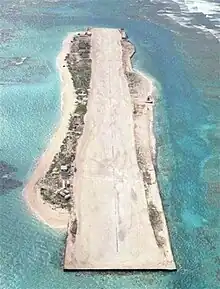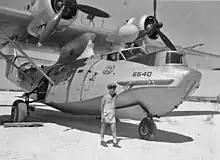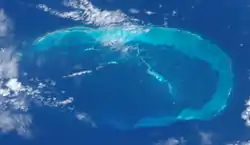Tern Island (Hawaii)
Tern Island is a tiny coral island located near French Frigate Shoals in the Northwestern Hawaiian Islands. It is approximately 490 miles (790 kilometers) west-northwest of Oahu.
| Geography | |
|---|---|
| Coordinates | 23.870°N 166.284°W |
| Area | 26.014 acres (10.527 ha) |


The island provides a breeding habitat to 18 species of seabirds, green sea turtles, and endangered Hawaiian monk seals.[1] It is maintained as a field station in the Hawaiian Islands National Wildlife Refuge by the United States Fish and Wildlife Service.
The island has an airstrip crossing the length of the island. This has been supported by the U.S. Navy, Coast Guard, and Wildlife Services since that time.
The US Fish & Wildlife Service closed its field station on the island at the end of 2012.[2] A naval base operated from 1942 to 1946, a Coast Guard base from 1952 to 1979, and a Fish & Wildlife station from 1979 to 2012.
The island has been protected by a double steel sea wall, however after so many decades it became a hazard for sealife, trapping endangered seals and turtles. As a result, Congress approved about 10 million dollars to repair the sea wall along with another million from a Federal agency, to do repairs of the seawall in the 2000 to 2003 timeline. However, it was only enough to do about half the repairs needed. By the 2020s, the danger of the corroded double steel wall is again noted during the research expeditions.
Tern island was recorded on Google Earth in the summer of 2013 as part of special project along with some other islands, the project took a series of images that allow different parts of it to be viewed online.
History
_(19722865924).jpg.webp)
.jpg.webp)

.jpg.webp)
The atoll is home to an airstrip created in 1942–3 that was used as Naval airstrop, and after WW2 the U.S. Coast Guard.[4] During World War II, ~130 people staffed the island, while the later wildlife station had between 5 and 15 staff.[5]
After the Battle of Midway in the summer of 1942, the U.S. Navy built a Naval Air Station there, enlarging the island to support a 3300 ft. (1005 m) landing strip. The station's main function was as an emergency landing site for planes flying between Hawaii and Midway Atoll. The original seawall, runway, and some of the buildings remain.
Construction started in July 1942. The facility was commissioned in March 1943 as a Naval Air Station.[6]
The base was meant to stop the Japanese using the atolls to attack mainland Hawaii, as had happened during Operation K. The island was expanded from 11 acres to 34 acres, and supported parking spots for 22 aircraft.[2] A 90-foot-tall radar tower and barracks for the island's crew were added.[2] Reconnaissance air patrols were flown from Tern island.[2]
The base had some defenses during WW2, including a battery of 90 mm guns, 3-inch guns, and 30 cal machine guns emplacements.[7] Having survived the battle of Midway, the base served as a stopping point for aircraft flying between Midway and the main Hawaiian islands, refueling or emergency landings.[7]
One emergency landing occurred in 1944, when a Curtiss C-46 Commando with dozens of marines aboard had an engine failure and was close to ditching in the ocean.[7] The twin-engine transport plane was down to an altitude of less than 300 feet, despite having ditched as much weight as feasible when it managed to land on Tern island.[7] The aircraft was able to land with one engine out, and fatalities were avoided.[7]
In 1945, Tern island hosted the USMC comedy show All Fouled Up when the entourage's R4D aircraft could not land at Midway due to fog.[7] The show was performed at Tern island.[7]
The naval base operated from 1942 to 1946, and a U.S. Coast Guard station operated from 1952 until 1979.[8] In 1969, a tsunami wiped out much of the station, and it had to be repaired.[9] The crew was evacuated by helicopter by the ship HMNZS Waikato, and taken to Midway.[3]
In 1946 two fisheries were established on Tern island, and they flew fish to Honolulu on a DC-3 aircraft.[3]
From 1961 to 1983 a missile tracking station operated there.[6]
Between 1986 and 1991 Tern Island was used to study the green sea turtle (Chelonia mydas).[10]
A Piper Aztec has landed over 600 times at Tern Island.[11] Monthly flights typically travel to Honolulu for mail, while heavier cargo usually comes by water.[12]
The Coast Guard barracks continued to be used into the 21st century.[11] Upgrades included the cleanup of old waste, improved water tanks, and solar power.[12] The solar power runs a reverse osmosis desalinator, capable of producing 1200 gallons a day.[12] A diesel generator runs off a 500-gallon fuel tank.[12]
In the summer of 2004, 1200 feet of seawall were repaired, and the boat dock was replaced by a boat ramp for small boats.[13] However, thousands of feet of seawall were still in need of repair.[13]
A Fish and Wild Life field station was active at the island from 1979 to 2012.[2] Closure came after a storm in December 2012, when several people evacuated from Tern island in advance of the storm.[14] The storm damaged facilities including the barracks.[14][15] Fish & Wildlife Service closed its field station at the end of 2012.[2]
In 2013, the island was imaged for a Google Street View project, to allow the islands to be viewed online.[4] Google and the US government worked to make five islands viewable as part of this project.[4] The other Pacific islands surveyed for the program included East Island (also in French Frigate Shoals), Laysan Island, Lisianski Island, and Pearl and Hermes Atoll.[16] The viewer allows a series of panoramic images from head height to be viewed around the island.[4] The path takes views along much of the length of the airstrip and along part of the shore.[4]
In 2013 the NOAA ship Oscar Sette visited the French Frigate Shoals and established a field camp on Tern island.[17] The storm at the end of 2012 had left the existing barracks uninhabitable, and the water system unusable.[17] Water had to be brought to the island in jugs.[17] The goods for the expedition were offloaded at the Tern island dock.[17]
In 2019, a full survey of green sea turtles on Tern island was conducted.[18] 371 green sea turtles were reported.[18]
In 2020, the beach was designated as environmentally polluted by plastic trash.[19] This ruling came after years of research at the site, including 14.5 thousand kilograms of trash discovered within 5000 meters of the beach over 11 years.[19] Over 70 percent of the trash was plastic.[19] Debris accumulation was studied in the 2010s.[20]
In 2020, the Papahanaumokuakea Marine Debris Project removed tens of thousands of pounds of debris from the French Frigate Shoals, including Tern island.[21]
Birds


The use of Tern Island by birds was studied.[22] One concern is birds eating plastic trash, which was studied between 2006 and 2013.[22] Tern Island is a popular research site to study Pacific sea and shore birds.[23]
Some sixteen seabird species inhabited Tern Island in the early 21st century,[24] including:[23][24]
- Sooty tern
- White tern
- Brown noddy
- Black noddy
- Masked booby
- Brown booby
- Red-footed booby
- Wedge-tailed shearwater
- Tristram's storm petrel
- Black-footed albatross
- Laysan albatross
- Great frigatebird
In 1998 and 1999, the black-footed albatross (Phoebastria nigripes) and Laysan albatross (Phoebastria immutabilis) were studied.[25] The research recorded a particularly unsuccessful nesting season for the albatrosses.[25]
In a 2010 study noted that other rare birds are sometimes seen at Tern.[26] Examples of birds occasionally seen at Tern Island include the short-eared owl (Asio flammeus) and fork-tailed swift (Apus pacificus).[26]
Tern Island is popular with green sea turtles; while in 1977 no nests were observed on the island; twenty years later, this had grown to around 700 nests.[27]
Migratory shorebirds known to winter at Tern in the early 21st century include:[2]
- Pacific golden plover (Pluvialis fulva)
- Ruddy turnstone (Arenaria interpres)
- Sanderling (Calidris alba)
- Wandering tattler (Heteroscelus incanus)
- Bristle-thighed curlew (Numenius tahitensis)
Seawall

During WW2 in response to the Japanese use of the atolls and to provide a link with Midway, the island was expanded to allow for a landing strip.[2] The island was protected from the surf by a 5000-foot double steel pylon seawall, with walls separated by 4 feet (over 1 meter) finished in 1943.[2] The original seawall is composed of over 5000 steel pilings.[6] Maintenance on the wall was conducted by the U.S. Coast Guard between 1952 and 1979.[2]
In 2000/1 the United States Congress approved US$10 million to repair the island.[28]
In 2004, the Fish & Wild Life service conducted a 12 million dollar project to repair the seawall and conduct other maintenance.[2] This project repaired 1200 feet of seawall.[2] The project was managed by the U.S. Army Corps of Engineers.[13]
In the 2020s concerns about decaying seawall on Tern island trapping turtles and seals was noted as a concern. The issue is that the its double wall steel wall but has not been maintained so holes have rusted out.[29]
Geography

Island beaches include:[20]
- Shell Beach & Crab Beach, on the north side of the island
- East Beach
- South Beach
A small boat ramp replaced dock and boat hoist in 2004.[13]
References
- "Tern Island Preliminary Assessment and Technical Support Document". epa.gov. December 9, 2015. Retrieved July 25, 2021.
- "TECHNICAL SUPPORT DOCUMENT TO THE PRELIMINARY ASSESSMENT OF THE FWS – HAWAIIAN ISLANDS NATIONAL WILDLIFE REFUGE: TERN ISLAND SITE IN THE FRENCH FRIGATE SHOALS, HAWAIʻI" (PDF). epa.gov. September 2014. Retrieved July 20, 2021.
- Atoll research bulletin. Smithsonian Libraries. Washington D.C.: Smithsonian Press. August 27, 1971. pp. 149–150.
{{cite book}}: CS1 maint: others (link) - Giaimo, Cara (March 7, 2018). "Go Tour This Digitized Island Full of Birds". Atlas Obscura. Retrieved July 24, 2021.
- "Population Dynamics of Hawaiian Seabird Colonies Vulnerable to Sea-Level Rise". researchgate.net. May 2012.
- Rottman, Gordon L. (2002). World War II Pacific Island Guide: A Geo-military Study. Greenwood Publishing Group. ISBN 978-0-313-31395-0.
- A. Binion, Amerson, Jr. (2012). The Coral Carrier: French Frigate Shoals, A History (PDF). p. 105. ISBN 978-0-9884645-0-6. Retrieved July 24, 2021.
{{cite book}}:|website=ignored (help)CS1 maint: multiple names: authors list (link) - "Tern Island". September 25, 2011. Archived from the original on September 25, 2011. Retrieved August 30, 2021.
- "LORAN STATION FRENCH FRIGATE SHO". www.loran-history.info. Archived from the original on October 27, 2019. Retrieved July 24, 2021.
- Niethammer, K.R.; Balazs, G.H.; Hatfield, J.S.; Nakai, G.L.; Megyesi, J.L. (1997). "Reproductive biology of the green turtle (Chelonia mydas) at Tern Island, French Frigate Shoals, Hawai'i". Pacific Science. 51 (1): 12.
- "Honolulu Star-Bulletin Hawaii News". archives.starbulletin.com. Retrieved July 24, 2021.
- "Tern Island at Work". February 9, 2012. Archived from the original on February 9, 2012. Retrieved July 24, 2021.
- "Tern Island Seawall Reconstruction Protects Wildlife Habitat and Monitoring Station". www.fws.gov. Retrieved July 24, 2021.
- "Biologists Evacuated from Remote Pacific Field Station: Storm damage to Tern Island facility is extensive" (PDF). December 21, 2012.
- "Papahānaumokuākea Marine National Monument". www.papahanaumokuakea.gov. Retrieved July 24, 2021.
- US Department of Commerce, National Oceanic and Atmospheric Administration. "A Virtual Tour of the Northwestern Hawaiian Islands". oceanservice.noaa.gov. Retrieved July 24, 2021.
- "NOAA Pacific Islands Fisheries Science Center Blog". NOAA Pacific Islands Fisheries Science Center Blog. Retrieved July 24, 2021.
- Fisheries, NOAA (January 27, 2021). "Researching and Rescuing Hawaiian Monk Seals and Green Sea Turtles | NOAA Fisheries". NOAA. Retrieved July 24, 2021.
- McAvoy, Audrey (July 21, 2020). "EPA finds plastic trash contaminates 2 remote Hawaii beaches". Washington Post. ISSN 0190-8286. Retrieved July 24, 2021.
- Agustin, Alyssa; Merrifield, Mark; Potemra, Jim; Morishige, Carey (January 2016). "Dynamics of Marine Debris Accumulation: Tern Island" (PDF). hawaii.edu. Retrieved July 24, 2021.
- Wu, Nina (November 14, 2020). "Over 82,000 pounds of trash removed from Papahanaumokuakea Marine National Monument". Honolulu Star-Advertiser. Retrieved July 24, 2021.
- Rapp, Dan C.; Youngren, Sarah M.; Hartzell, Paula; David Hyrenbach, K. (October 15, 2017). "Community-wide patterns of plastic ingestion in seabirds breeding at French Frigate Shoals, Northwestern Hawaiian Islands". Marine Pollution Bulletin. 123 (1–2): 269–278. Bibcode:2017MarPB.123..269R. doi:10.1016/j.marpolbul.2017.08.047. ISSN 1879-3363. PMID 28844458.
- "Honolulu Star-Bulletin News /2005/08/19/". archives.starbulletin.com. Retrieved July 24, 2021.
- "Research TernIsland Plastic". www.pelagicos.net. Retrieved July 24, 2021.
- "OBIS-SEAMAP Dataset – Tern Island Albatrosses – 1999". seamap.env.duke.edu. Retrieved July 24, 2021.
- HOWARD, PHILLIP; HARVEY, SARAH C. "Rare and Unusual Birds Observed on Tern Island, French Frigate Shoals, Northwestern Hawaiian Islands" (PDF). westernfieldornithologists.org. Retrieved July 24, 2021.
- Rauzon, Mark J. (November 1, 2000). Isles of Refuge: Wildlife and History of the Northwestern Hawaiian Islands. University of Hawaii Press. ISBN 978-0-8248-2330-6.
- "Honolulu Star-Bulletin Hawaii News". archives.starbulletin.com. Retrieved July 24, 2021.
- Magazine, Smithsonian; Spring, Joe. "The Lonely Battle to Save Species on a Tiny Speck in the Pacific". Smithsonian Magazine. Retrieved October 8, 2023.
External links
- Ternisland.com
- Tern Island: Noah's Ark of the Hawaiian Isles Archived September 6, 2005, at the Wayback Machine
- Satellite View
- Google Street View July 2013
- Visible Earth
- Naval History YHB-10 (Used as barracks during WW2 at Tern island)
